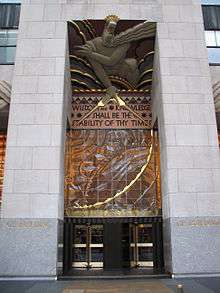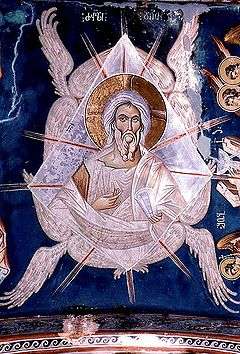Ancient of Days
_British_Museum.jpg)
Watercolor etching by William Blake

Ancient of Days, or Head of Days, is a name for God in the Book of Daniel: in the original Aramaic Atik Yomin; in the Greek Septuagint Palaios Hemeron; and in the Vulgate Antiquus Dierum.
The title "Ancient of Days" has been used as a source of inspiration in art and music, denoting the Creator's aspects of eternity combined with perfection. William Blake's watercolour and relief etching entitled "The Ancient of Days" is one such example.
In Religion
Judaism
- See also Names of God in Judaism
There are many sources for this term, including:
I beheld till the thrones were cast down, and the Ancient of Days did sit, whose garment was white as snow, and the hair of his head like the pure wool: his throne was like the fiery flame, and his wheels as burning fire.
Daniel 7:9
Whenever Judgment looms and the forehead of the Impatient One is revealed, the Forehead of the Ancient of Ancients is revealed; Judgment subsides and is not executed.
Idra Rabba, Zohar 3:136b
This term appears three times in the Book of Daniel (7:9, 13, 22),[1] and is used in the sense of God being eternal.[2]
The most powerful effect of this particular Name of God stems from the Jewish mystical book the Zohar, the seminal document of Kabbalah that emerged in 13th century Spain. In the Kabbalah there is mention of the Ancient of Ancients, and the Holy Ancient One – Atika Kadisha, variably interpreted as synonymous with the En Sof, the unmanifested Godhead. The Ancient of Days is the manifestation of the Ancient of Ancients within Creation. It refers to the most primary ("ancient") source of Creation in the Divine Will Keter ("Crown").
In 16th century Lurianic Kabbalah, Atik Yomin is systemised as the uppermost Partzuf (Divine "Countenance/Configuration") in the rectification of the World of Atzilut ("Emanation") after the "Shattering of the sephirot Vessels". Keter of Atzilut acts as the guiding Divine motivation in Creation, developing into two partzufim, Atik Yomin (Ancient of Days) and Arich Anpin ("Long Visage/Infinitely Patient One"). Atik Yomin is the inner partzuf of Keter, synonymous with Divine Delight, that enclothes within and motivates Arich Anpin, the outer partzuf of Keter, synonymous with Divine Will. Arich Anpin is said to extend down all levels of Creation in ever more concealed mode as the Divine substratum of everything. The Zohar goes into great detail describing the White Head of God and ultimately the emanation of its anthropomorphic personality or attributes.[3] In the descending realms explained by Luria, the Gulgalta ("Skull"-Keter Will) within Arich Anpin enclothes the Chesed (Kindness) of Atik Yomin, becoming the origin of the lights of the world of Atzilut; the Mocha Stima'ah ("Concealed Brain"-Chokhmah Wisdom) within Arich Anpin enclothes the Gevurah (Severity) of Atik Yomin, becoming the origin of the vessels of the world of Atzilut.[4] The Dikna ("Beard") of Arich Anpin constricts the infinite light originating from Atik Yomin in 13 channels of rectification to lower, relatively finite reality.[5] The Merkabah text Re’ uyot Yehezkel identifies the Ancient of Days as Metatron.[6]
Christianity
In Eastern Orthodox Christian hymns and icons, the Ancient of Days is sometimes identified with God the Father or occasionally The Holy Spirit; but most properly, in accordance with Orthodox theology he is identified with God the Son, or Jesus Christ. Most of the eastern church fathers who comment on the passage in Daniel (7:9-10, 13-14) interpreted the elderly figure as a prophetic revelation of the Son before his physical Incarnation.[7] As such, Eastern Christian art will sometimes portray Jesus Christ as an old man, the Ancient of Days, to show symbolically that he existed from all eternity, and sometimes as a young man, or wise baby, to portray him as he was incarnate. This iconography emerged in the 6th century, mostly in the Eastern Empire with elderly images, though usually not properly or specifically identified as "the Ancient of Days."[8] The first images of the Ancient of Days, so named with an inscription, were developed by iconographers in different manuscripts, the earliest of which are dated to the eleventh century. The images in these manuscripts included the inscription "Jesus Christ, Ancient of Days," confirming that this was a way to identify Christ as pre-eternal with the God the Father.[9] Indeed, later, it was declared by the Russian Orthodox Church at the Great Synod of Moscow in 1667 that the Ancient of Days was the Son and not the Father.[10]
In the Western Church similar figures usually represent only God the Father. Building his argument upon the Daniel passage, Thomas Aquinas recalls that some bring forward the objection that the Ancient of Days matches the Person of the Father, without necessarily agreeing with this statement himself.[11]
In the hymn "Immortal, Invisible, God only Wise", the last two lines of the first verse read:
- Most blessed, most glorious, the Ancient of Days,
- Almighty, victorious, Thy great Name we praise.
Daniel 7:13-14 says, “I kept on beholding in the visions of the night, and, see there! with the clouds of the heavens someone like a son of man happened to be coming; and to the Ancient of Days he gained access, and they brought him up close even before that One. And to him there were given rulership and dignity and kingdom, that the peoples, national groups and languages should all serve even him. His rulership is an indefinitely lasting rulership that will not pass away, and his kingdom one that will not be brought to ruin." The Ancient of Days [God the Father] bestowing upon the Son of Man [God the Son, Jesus] a kingdom and honor would suggest that they are two distinct identities. Among ancient Christian pseudepigrapha, one Book of Enoch states that He who is called “Son of man,” who existed before the worlds were, is seen by Enoch in company with the “Ancient of Days”[12]
Mormonism
In The Church of Jesus Christ of Latter-day Saints, the title Ancient of Days belongs to Adam, the oldest and earliest man, who is also identified with the archangel Michael.[13][14]
Hinduism
The Sanskrit name, Karttikeya or Skanda, means "always a youth" and is revered as one of the four (or seven) sons of Brahma.[15]
Bahá’í
In the Bahá’í Faith, 'the Ancient of Days' is one of the titles with which Bahá’u’lláh refers to Himself.[16]
Modern references
In music
- Ancient of Days is a well-known Anglican hymn, also known by its tune, Albany, by William Doane, the first Episcopal bishop of Albany, New York.[17]
- "Ancient of Days" is a song by Van Morrison from his 1984 album A Sense of Wonder
- "Ancient of Days" is a gospel song by Ron Kenoly from his 1992 album Lift Him Up with Ron Kenoly
- "The Ancient of Days", is a 1992 song composed by Gary Sadler and Jamie Harvill.
- The Blake image was used as the cover of a 1978 album by the band Slave
- Ancient of Days is the name of a metal band from Leeds, England.
- Referenced by Tuomas Holopainen in the song "Dead Gardens" on the 2004 release of Once.
- "Ancient of Days" Debut 2011 EP/CD from Kingston, Ontario Alternative Bluegrass Band SwampBug
- "Ancient of Days" is the cover cd of TWIN FUSION's Identical Creation Cd, its first release by an American prog rock band, by Mike Harris, Dave Harris, and Rick Hall.
- "Thank you for the days, those ancient days you gave to me". Song by Ray Davies.
- "Ancient of days" is a song by Petra from their 1997 Album: Petra Praise 2: We Need Jesus
In literature
- In J. R. R. Tolkien's epic "The Lord of the Rings," immediately after Aragorn is crowned King Elessar of Gondor, "ancient of days he seemed" to those watching, "and yet in the flower of manhood...."
- In Irving A. Greenfield's 1973 bestseller Ancient of Days: The Chronicles of Ronstrom the Builder, Ronstrom the Hunter, prompted by God, launches his tribe on the epic building project that would become Stonehenge.
- Science fiction author Michael Bishop wrote a novel in 1985 called Ancient of Days, about a Homo habilis discovered living in 20th century America.
- The 'Ancient of Days' is a term for God in Phillip Pullman's 'His Dark Materials' trilogy.
- In the last stanza of his poem "Atlantis," W.H. Auden writes the following: "And may the Ancient of Days provide for all you must do his invisible guidance, lifting up, dear, upon your face the light of his countenance."
- In the book series by the Irish author Michael Scott,The Secrets of the Immortal Nicholas Flamel, from book three, The Sorceress, and onward, Gilgamesh the King, the oldest immortal in the world, is sometimes referred to as the "Ancient of Days."
Notes
- ↑ "Daniel 7". BibleGateway.com (KJV). Retrieved 21 January 2008.
- ↑ Easton, M. G. (1897). Easton's Bible Dictionary, "Ancient of Days". "In contrast with all earthly kings, his days are past reckoning."
- ↑ "Glossary entry for Ancient of Days". Archived from the original on 2007-07-02. Retrieved 2007-07-02.
- ↑ Recification in Keter of Atzilut from inner.org
- ↑ Rectification in Keter of Atzilut from inner.org
- ↑ Nathaniel Deutsch (1999). Guardians of the Gate: Angelic Vice-regency in the Late Antiquity. BRILL. pp. 45–47. Retrieved 5 March 2014.
- ↑ McKay, Gretchen K. (1999). ""The Eastern Christian Exegetical Tradition of Daniel's Vision of the Ancient of Days"". Journal of Early Christian Studies.
- ↑ Cartlidge and Elliott, 69-72
- ↑ The manuscripts that include an image of the Ancient of Days are discussed in the unpublished dissertation by Gretchen Kreahling McKay, "Imaging the Divine: A Study of the Representations of the Ancient of Days in Byzantine Manuscripts," University of Virginia, 1997.
- ↑ The Tome of the Great Council of Moscow (1666-1667 A.D.), Ch. 2, 43-45; tr. Hierodeacon Lev Puhalo, Canadian Orthodox Missionary Journal
- ↑ Summa Theologica III.59.1 obj 2, ad 2
- ↑ "Book of Enoch". Pseudepigrapha: An Account of Certain Apocryphal Sacred Writings of the Jews and Early Christians. Christian Classics Etherial Library. Retrieved 2 July 2011.
- ↑ Doctrine and Covenants 27:11
- ↑ Millet, Robert L. (February 1998), "The Man Adam", Liahona
- ↑ Dowson, John (1820-1881) (1879). A classical dictionary of Hindu mythology and religion, geography, history, and literature. London: Trübner. [Reprint, London: Routledge, 1979]. ISBN 0-415-24521-4
- ↑ The World Order of Bahá’u’lláh, Shoghi Effendi, US Bahá’í Publishing Trust, 1991 first pocket-size edition, pg. 206
- ↑ W.C. Doane, Ancient of Days, or Albany, Song # 363, The Hymnal 1982 (Church Publishing 1982), ISBN 0-89869-120-6.
References
- Cartlidge, David R., and Elliott, J.K.; Art and the Christian Apocrypha, Routledge, 2001, ISBN 0-415-23392-5, ISBN 978-0-415-23392-7, Google books
- The Sorceress by Michael Scott, Delacorte Press, 2009, ISBN 978-0-385-73529-2
